Michael Maire
Hierarchical Implicit Neural Emulators
Jun 05, 2025Abstract:Neural PDE solvers offer a powerful tool for modeling complex dynamical systems, but often struggle with error accumulation over long time horizons and maintaining stability and physical consistency. We introduce a multiscale implicit neural emulator that enhances long-term prediction accuracy by conditioning on a hierarchy of lower-dimensional future state representations. Drawing inspiration from the stability properties of numerical implicit time-stepping methods, our approach leverages predictions several steps ahead in time at increasing compression rates for next-timestep refinements. By actively adjusting the temporal downsampling ratios, our design enables the model to capture dynamics across multiple granularities and enforce long-range temporal coherence. Experiments on turbulent fluid dynamics show that our method achieves high short-term accuracy and produces long-term stable forecasts, significantly outperforming autoregressive baselines while adding minimal computational overhead.
Nested Diffusion Models Using Hierarchical Latent Priors
Dec 08, 2024Abstract:We introduce nested diffusion models, an efficient and powerful hierarchical generative framework that substantially enhances the generation quality of diffusion models, particularly for images of complex scenes. Our approach employs a series of diffusion models to progressively generate latent variables at different semantic levels. Each model in this series is conditioned on the output of the preceding higher-level models, culminating in image generation. Hierarchical latent variables guide the generation process along predefined semantic pathways, allowing our approach to capture intricate structural details while significantly improving image quality. To construct these latent variables, we leverage a pre-trained visual encoder, which learns strong semantic visual representations, and modulate its capacity via dimensionality reduction and noise injection. Across multiple datasets, our system demonstrates significant enhancements in image quality for both unconditional and class/text conditional generation. Moreover, our unconditional generation system substantially outperforms the baseline conditional system. These advancements incur minimal computational overhead as the more abstract levels of our hierarchy work with lower-dimensional representations.
PROGRESSOR: A Perceptually Guided Reward Estimator with Self-Supervised Online Refinement
Nov 26, 2024Abstract:We present PROGRESSOR, a novel framework that learns a task-agnostic reward function from videos, enabling policy training through goal-conditioned reinforcement learning (RL) without manual supervision. Underlying this reward is an estimate of the distribution over task progress as a function of the current, initial, and goal observations that is learned in a self-supervised fashion. Crucially, PROGRESSOR refines rewards adversarially during online RL training by pushing back predictions for out-of-distribution observations, to mitigate distribution shift inherent in non-expert observations. Utilizing this progress prediction as a dense reward together with an adversarial push-back, we show that PROGRESSOR enables robots to learn complex behaviors without any external supervision. Pretrained on large-scale egocentric human video from EPIC-KITCHENS, PROGRESSOR requires no fine-tuning on in-domain task-specific data for generalization to real-robot offline RL under noisy demonstrations, outperforming contemporary methods that provide dense visual reward for robotic learning. Our findings highlight the potential of PROGRESSOR for scalable robotic applications where direct action labels and task-specific rewards are not readily available.
Approaching Deep Learning through the Spectral Dynamics of Weights
Aug 21, 2024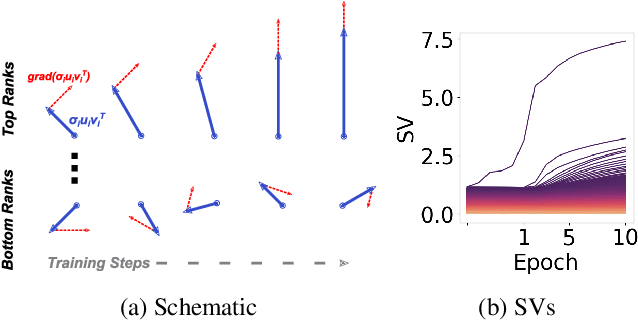
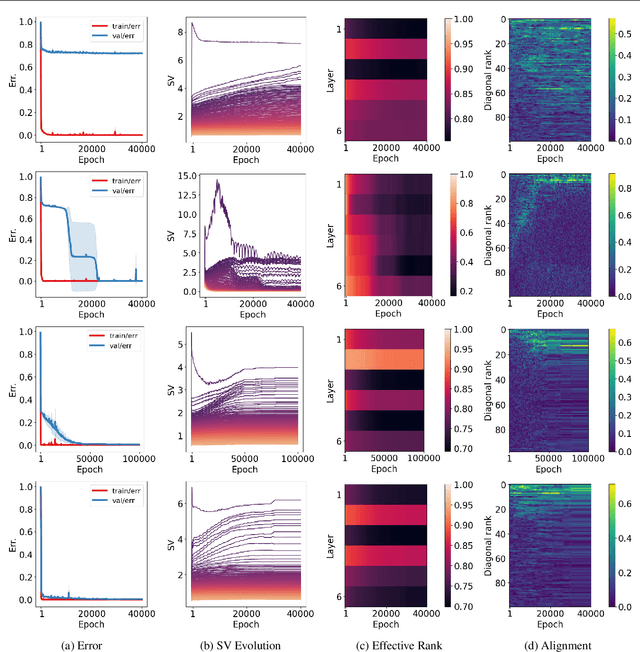
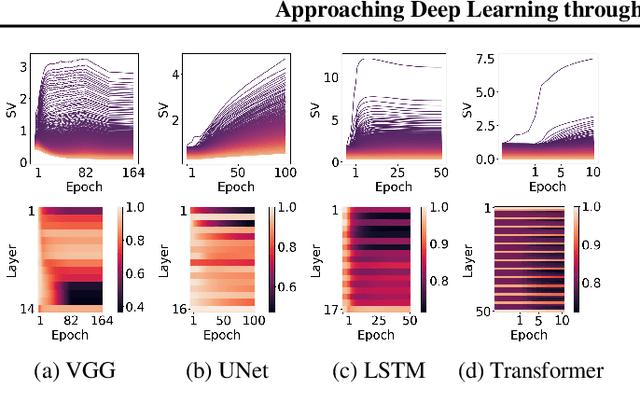
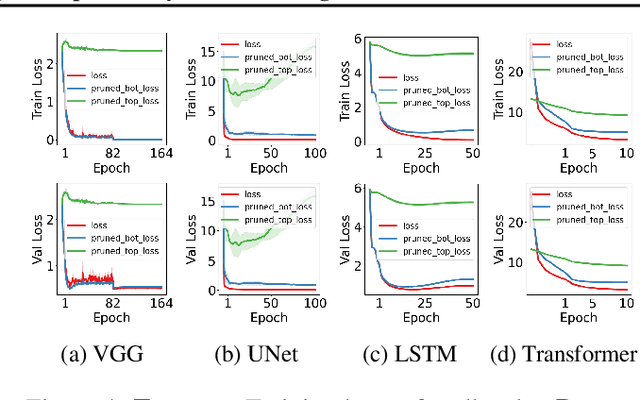
Abstract:We propose an empirical approach centered on the spectral dynamics of weights -- the behavior of singular values and vectors during optimization -- to unify and clarify several phenomena in deep learning. We identify a consistent bias in optimization across various experiments, from small-scale ``grokking'' to large-scale tasks like image classification with ConvNets, image generation with UNets, speech recognition with LSTMs, and language modeling with Transformers. We also demonstrate that weight decay enhances this bias beyond its role as a norm regularizer, even in practical systems. Moreover, we show that these spectral dynamics distinguish memorizing networks from generalizing ones, offering a novel perspective on this longstanding conundrum. Additionally, we leverage spectral dynamics to explore the emergence of well-performing sparse subnetworks (lottery tickets) and the structure of the loss surface through linear mode connectivity. Our findings suggest that spectral dynamics provide a coherent framework to better understand the behavior of neural networks across diverse settings.
Generative Lifting of Multiview to 3D from Unknown Pose: Wrapping NeRF inside Diffusion
Jun 11, 2024Abstract:We cast multiview reconstruction from unknown pose as a generative modeling problem. From a collection of unannotated 2D images of a scene, our approach simultaneously learns both a network to predict camera pose from 2D image input, as well as the parameters of a Neural Radiance Field (NeRF) for the 3D scene. To drive learning, we wrap both the pose prediction network and NeRF inside a Denoising Diffusion Probabilistic Model (DDPM) and train the system via the standard denoising objective. Our framework requires the system accomplish the task of denoising an input 2D image by predicting its pose and rendering the NeRF from that pose. Learning to denoise thus forces the system to concurrently learn the underlying 3D NeRF representation and a mapping from images to camera extrinsic parameters. To facilitate the latter, we design a custom network architecture to represent pose as a distribution, granting implicit capacity for discovering view correspondences when trained end-to-end for denoising alone. This technique allows our system to successfully build NeRFs, without pose knowledge, for challenging scenes where competing methods fail. At the conclusion of training, our learned NeRF can be extracted and used as a 3D scene model; our full system can be used to sample novel camera poses and generate novel-view images.
Latent Intrinsics Emerge from Training to Relight
May 31, 2024



Abstract:Image relighting is the task of showing what a scene from a source image would look like if illuminated differently. Inverse graphics schemes recover an explicit representation of geometry and a set of chosen intrinsics, then relight with some form of renderer. However error control for inverse graphics is difficult, and inverse graphics methods can represent only the effects of the chosen intrinsics. This paper describes a relighting method that is entirely data-driven, where intrinsics and lighting are each represented as latent variables. Our approach produces SOTA relightings of real scenes, as measured by standard metrics. We show that albedo can be recovered from our latent intrinsics without using any example albedos, and that the albedos recovered are competitive with SOTA methods.
Residual Connections Harm Self-Supervised Abstract Feature Learning
Apr 16, 2024Abstract:We demonstrate that adding a weighting factor to decay the strength of identity shortcuts within residual networks substantially improves semantic feature learning in the state-of-the-art self-supervised masked autoencoding (MAE) paradigm. Our modification to the identity shortcuts within a VIT-B/16 backbone of an MAE boosts linear probing accuracy on ImageNet from 67.3% to 72.3%. This significant gap suggests that, while residual connection structure serves an essential role in facilitating gradient propagation, it may have a harmful side effect of reducing capacity for abstract learning by virtue of injecting an echo of shallower representations into deeper layers. We ameliorate this downside via a fixed formula for monotonically decreasing the contribution of identity connections as layer depth increases. Our design promotes the gradual development of feature abstractions, without impacting network trainability. Analyzing the representations learned by our modified residual networks, we find correlation between low effective feature rank and downstream task performance.
Deciphering 'What' and 'Where' Visual Pathways from Spectral Clustering of Layer-Distributed Neural Representations
Dec 11, 2023Abstract:We present an approach for analyzing grouping information contained within a neural network's activations, permitting extraction of spatial layout and semantic segmentation from the behavior of large pre-trained vision models. Unlike prior work, our method conducts a wholistic analysis of a network's activation state, leveraging features from all layers and obviating the need to guess which part of the model contains relevant information. Motivated by classic spectral clustering, we formulate this analysis in terms of an optimization objective involving a set of affinity matrices, each formed by comparing features within a different layer. Solving this optimization problem using gradient descent allows our technique to scale from single images to dataset-level analysis, including, in the latter, both intra- and inter-image relationships. Analyzing a pre-trained generative transformer provides insight into the computational strategy learned by such models. Equating affinity with key-query similarity across attention layers yields eigenvectors encoding scene spatial layout, whereas defining affinity by value vector similarity yields eigenvectors encoding object identity. This result suggests that key and query vectors coordinate attentional information flow according to spatial proximity (a `where' pathway), while value vectors refine a semantic category representation (a `what' pathway).
SySMOL: A Hardware-software Co-design Framework for Ultra-Low and Fine-Grained Mixed-Precision Neural Networks
Nov 23, 2023Abstract:Recent advancements in quantization and mixed-precision techniques offer significant promise for improving the run-time and energy efficiency of neural networks. In this work, we further showed that neural networks, wherein individual parameters or activations can take on different precisions ranging between 1 and 4 bits, can achieve accuracies comparable to or exceeding the full-precision counterparts. However, the deployment of such networks poses numerous challenges, stemming from the necessity to manage and control the compute/communication/storage requirements associated with these extremely fine-grained mixed precisions for each piece of data. There is a lack of existing efficient hardware and system-level support tailored to these unique and challenging requirements. Our research introduces the first novel holistic hardware-software co-design approach for these networks, which enables a continuous feedback loop between hardware design, training, and inference to facilitate systematic design exploration. As a proof-of-concept, we illustrate this co-design approach by designing new, configurable CPU SIMD architectures tailored for these networks, tightly integrating the architecture with new system-aware training and inference techniques. We perform systematic design space exploration using this framework to analyze various tradeoffs. The design for mixed-precision networks that achieves optimized tradeoffs corresponds to an architecture that supports 1, 2, and 4-bit fixed-point operations with four configurable precision patterns, when coupled with system-aware training and inference optimization -- networks trained for this design achieve accuracies that closely match full-precision accuracies, while compressing and improving run-time efficiency of the neural networks drastically by 10-20x, compared to full-precision networks.
HyperFields: Towards Zero-Shot Generation of NeRFs from Text
Oct 27, 2023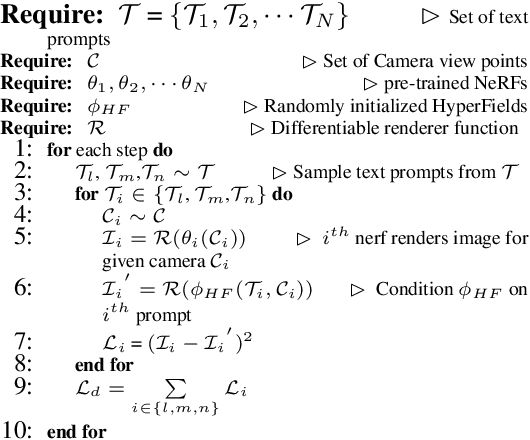


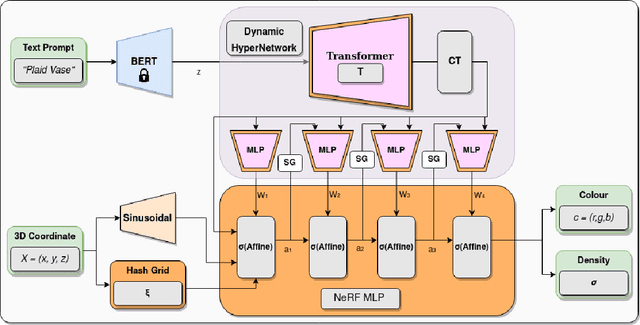
Abstract:We introduce HyperFields, a method for generating text-conditioned Neural Radiance Fields (NeRFs) with a single forward pass and (optionally) some fine-tuning. Key to our approach are: (i) a dynamic hypernetwork, which learns a smooth mapping from text token embeddings to the space of NeRFs; (ii) NeRF distillation training, which distills scenes encoded in individual NeRFs into one dynamic hypernetwork. These techniques enable a single network to fit over a hundred unique scenes. We further demonstrate that HyperFields learns a more general map between text and NeRFs, and consequently is capable of predicting novel in-distribution and out-of-distribution scenes -- either zero-shot or with a few finetuning steps. Finetuning HyperFields benefits from accelerated convergence thanks to the learned general map, and is capable of synthesizing novel scenes 5 to 10 times faster than existing neural optimization-based methods. Our ablation experiments show that both the dynamic architecture and NeRF distillation are critical to the expressivity of HyperFields.
 Add to Chrome
Add to Chrome Add to Firefox
Add to Firefox Add to Edge
Add to Edge